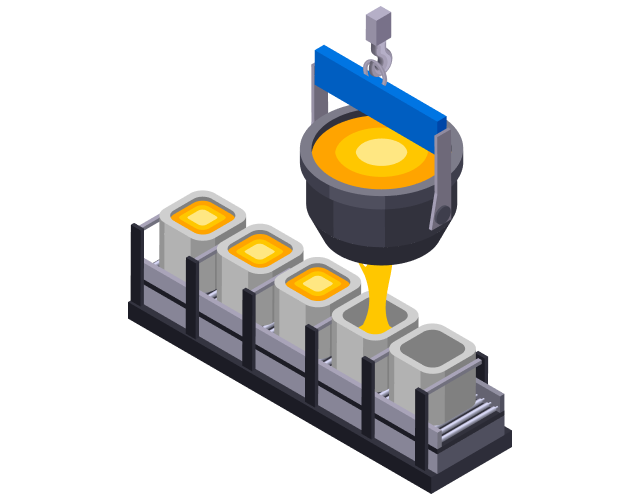Inside the Aluminum Foundry process: efficiency in every pour
Wiki Article
A Deep Dive Into the Various Types of Metal Casting and Their Utilizes
Metal Casting includes numerous techniques, each customized for details applications and requirements. From the cost-effective sand spreading technique to the accuracy of investment casting, each process has distinct benefits. Die casting stands apart in high-volume manufacturing scenarios, while lost foam spreading introduces cutting-edge layout possibilities. In addition, permanent mold and mildew spreading is recognized for its longevity. Comprehending these techniques opens up a home window into their sensible usages and implications in numerous sectors. What exists beneath the surface area of these spreading techniques?Sand Casting: A Functional and Cost-efficient Method
Different casting techniques exist, sand spreading remains one of the most flexible and economical strategies in the metalworking market. This method employs a mixture of sand and a binding agent to produce mold and mildews, enabling the manufacturing of parts in varied sizes and forms. Sand spreading is particularly advantageous for little to medium manufacturing runs, as it calls for marginal upfront financial investment in tooling contrasted to other casting strategies.The procedure begins with the creation of a mold and mildew, where liquified steel is poured in to create the preferred object as soon as cooled. Its versatility allows the use of numerous steels, consisting of iron, steel, and light weight aluminum. Furthermore, sand casting can fit complicated geometries, making it appropriate for a series of applications, from vehicle components to elaborate artistic pieces. In general, sand casting's efficiency and adaptability strengthen its importance in the manufacturing landscape.
Investment Spreading: Accuracy and Detail for Complex Shapes
Investment spreading attracts attention as an approach renowned for its capability to produce very detailed and detailed elements. This process involves producing a wax pattern that is coated with a ceramic covering, which is after that heated up to remove the wax and harden the covering. The result is an accurate mold that can capture intricate geometric shapes with impressive precision.This casting technique is particularly beneficial for creating components with slim walls, fine functions, and tight resistances, making it excellent for markets such as aerospace, auto, and medical tools. Investment casting accommodates a range of metals, consisting of stainless-steel, aluminum, and titanium, allowing suppliers to meet particular material demands.
Additionally, the procedure minimizes machining demands post-casting, which can improve effectiveness and decrease production prices. Overall, financial investment spreading is a favored option for applications where accuracy and detail are paramount.
Die Casting: High-Volume Production With Excellent Surface Area Finish

Die spreading is a highly efficient manufacturing procedure that stands out in creating big quantities of steel get rid of outstanding surface coatings. This method entails requiring liquified steel into a mold and mildew dental caries under high stress, allowing for fast production cycles and harmony in the ended up products. Commonly utilized products consist of zinc, light weight aluminum, and magnesium, which supply outstanding mechanical homes and corrosion resistance.
Pass away casting is especially advantageous for sectors such as auto, electronic devices, and durable goods, where precision and high quality are vital. The process enables elaborate layouts, decreasing the demand for extra machining and ending up processes. Furthermore, the smooth surfaces developed with die casting typically need minimal post-processing, resulting in lower total manufacturing expenses. As a high-volume manufacturing method, pass away casting is suitable for makers looking for performance without jeopardizing on quality, making it a favored option for many applications across various sectors.
Lost Foam Spreading: Cutting-edge Technique for Intricate Styles
Lost foam spreading revolutionizes the manufacturing of intricate metal components by utilizing a distinct process that eliminates the demand for standard mold and mildews. Instead of conventional mold-making, this technique uses a foam pattern that is covered with a refractory material. Once the pattern is established, liquified steel click to read is poured directly into the mold and mildew, causing the foam to leave and evaporate behind an exact cavity for the steel to fill up. This ingenious method allows for detailed layouts and in-depth attributes that may be challenging to achieve with other casting techniques.In addition, lost foam casting can lower waste and energy usage, making it an eco pleasant alternative. Industries such as aerospace and auto advantage considerably from this strategy, as it sustains the creation of lightweight parts with complicated geometries. Overall, lost foam casting stands out for its ability to supply premium, tailored steel components successfully.
Irreversible Mold Spreading: Toughness and Uniformity in Metal Components
Permanent mold spreading is an extremely efficient approach for producing consistent and resilient metal components, leveraging recyclable molds that are usually made from metals such as iron or steel. This casting process involves putting liquified metal right into these molds, which are preheated to boost item high quality and lower flaws. Using reusable mold and mildews not only decreases waste yet also permits greater manufacturing prices, making it financially advantageous for producers.The resulting components display exceptional dimensional accuracy and surface coating, making them suitable for applications in auto, aerospace, and industrial machinery. Furthermore, his comment is here permanent mold and mildew spreading can accommodate a range of alloys, even more find out here now expanding its flexibility. The resilience of the actors components is improved due to the regulated air conditioning rates that promote finer grain structures. In general, this casting method stands out for its ability to create high-quality metal components that meet strenuous efficiency standards, ensuring dependability popular atmospheres.
Frequently Asked Questions
What Products Can Be Utilized in Different Steel Casting Procedures?

Numerous products can be utilized in Metal Casting processes, including aluminum, zinc, bronze, and iron. Each material uses one-of-a-kind properties, affecting the casting method's performance, stamina, and viability for various applications in production.
Exactly How Do Casting Techniques Impact the Mechanical Features of Metals?
Casting techniques significantly influence the mechanical properties of steels, impacting factors like stamina, ductility, and firmness. Variations in cooling down prices and mold materials can cause different microstructures, inevitably affecting the performance of the end product.What Are the Environmental Effects of Metal Casting Processes?
Metal Casting processes can cause air and water pollution, source exhaustion, and significant energy intake (Aluminum Foundry). Furthermore, the generation of waste materials and greenhouse gas discharges substantially influences the setting and contributes to environment adjustmentJust how Do You Choose the Right Casting Method for a Job?
Picking the right casting method entails reviewing project demands, product residential properties, intricacy, and manufacturing quantity. Variables like expense effectiveness, surface high quality, and lead time additionally play vital roles in determining one of the most suitable strategy.What Safety and security Safety Measures Should Be Taken Throughout Metal Casting Procedures?
Throughout Metal Casting operations, safety and security precautions include putting on protective gear, making sure appropriate ventilation, carrying out devices examinations, preserving a clean work space, and having emergency procedures in position to take care of potential risks like burns or toxic fumes.From the cost-effective sand casting method to the precision of financial investment spreading, each process has unique advantages. Die spreading is an extremely reliable production process that stands out in creating big volumes of metal components with extraordinary surface coatings. Lost foam casting reinvents the manufacturing of complex steel parts by using an unique procedure that eliminates the demand for traditional mold and mildews (Metal Castings). Irreversible mold and mildew casting is a very effective approach for generating long lasting and constant steel components, leveraging recyclable molds that are normally made from steels such as iron or steel. Different materials can be made use of in Metal Casting procedures, consisting of light weight aluminum, zinc, iron, and bronze
Report this wiki page